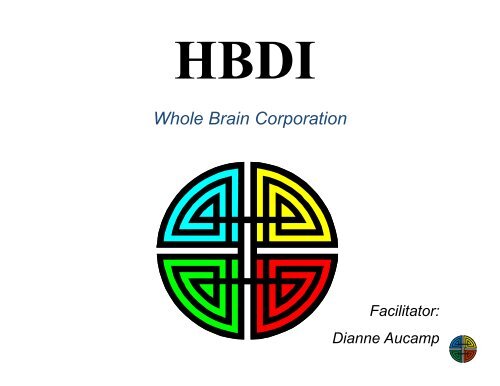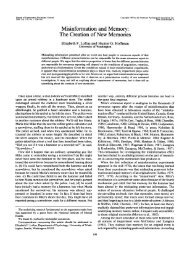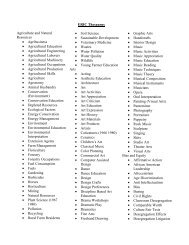HBDI - 1
HBDI - 1
HBDI - 1
Create successful ePaper yourself
Turn your PDF publications into a flip-book with our unique Google optimized e-Paper software.
<strong>HBDI</strong>Whole Brain CorporationFacilitator:Dianne Aucamp
AWhole Brain ModelALogicalAnalyticalFact BasedQuantitativeHolisticIntuitiveIntegratingSynthesizingDBOrganizedSequentialPlannedDetailedInterpersonalFeeling BasedKinestheticEmotionalC
Our Personal Share of the Four SelvesKnowingthe FactsFindingthe WayMake itHappenDealing withFeelings
Impact of Thinking Styles:BRAIN DOMINANCELEADSThinking Style PreferencesIMPACTSHow BrainDominance Leadsto Bottom LineOutcomes inBusiness,Learning and Life•What we pay attention to•What we learn best•What motivates us•How we communicateINFLUENCES•How we do what we do•How we make decisions•What we are successful at•How we interact with the world
Rational SelfAnalyzesAQuantifiesIs logicalIs criticalIs realisticLikes numbersKnows about moneyKnows how things work
Safekeeping SelfTake preventive actionEstablishes proceduresGets things doneIs reliableIs neatTimelyPlansB
P.B.’s Personal Organizer
Feeling SelfIs sensitive to othersLikes to teachTouches a lotIs supportiveIs expressiveIs emotionalTalks a lotFeelsC
Experimental SelfInfersImaginesSpeculatesTake risksIs ImpetuousBreaks rulesLikes surprisesIs curious / PlaysD
J.M.F’s Personal Organizer
Clear, concise, contentheavyWhen learning I enjoy:•Acquiring & quantifying facts•Applying analysis and logic•Thinking through ideas•Forming theories•Critiquing•Case Studies•Higher OrderReasoningWHOLE BRAIN LEARNINGCONSIDERATIONSFree, open choice, openagendaWhen learning I enjoy:•Learning from my intuitive insights•Discovery, exploring hiddenpossibilities•Day dreaming...playing•Using my imagination•Seeing the big picture•Conceptualizing ,synthesizingcontent•An informal climateExplorerWhen learning I enjoy:•Organized, structured content &agenda•Step by step flow of information•Evaluating ideas, theories•Acquiring skills through practice•Verifying my understanding•Explicit directions•A methodical approachWhen learning I enjoy:•Integrating experienceswith self•Listening and sharing ideas•Relying on intuitive feelings•Internalizing the content•Emotional involvement•Hands on experiences•Stories, role plays, musicGuided, paced,tutorialPossibility for sharing,interaction with others132
What Happens When the Blue Meets Red andGreen Meets Yellow? A Disconnect!A Upper Left –Blue“That rep just seems to talktoo much. I don’t have time towaste chit-chatting—I justwant the information I need.”D Upper Right-YellowHe is killing me with details I do notneed! I wish we had a rep who couldjust give me an overview of theproduct without getting boggeddown in all of that minutiae.I can’t ever follow that rep’s trainof thought. She keeps jumpingfrom topic to topic-I do not thinkthat is an orderly andprofessional way to presentinformation.The arrogance of that rep astoundsme! I cannot trust someone who willnot take the time to talk about myspecific needs.B Lower Left-GreenC Lower Right-Red© 1987-2003 The Ned Herrmann Group
ValuesFactsIdeasActionsRelationships
Concerned WithWhatWhyHowWho
Approaches to $Ways to CountWays to SpendWays to SaveWays to Help
Writing StylesTerseVerseOutlineProse
May Overlook/AvoidFeelingsDetails/DeadlinesNew Ideas/AmbiguityFacts/TimeMoney
DressFunctionalIndividualisticCorrectComfortable
LanguageLogic & ReasonIntuition & ImaginationStructure & ControlFeelings & Emotions
Can Appear To BeColdAloofArrogantAmbiguousBoringInsensitiveOverly EmotionalDramatic
Base Decision OnData & FactsPossibilitiesControlAffect On Others
Primary WeaknessFeelingStructureChangeLogic
<strong>HBDI</strong> ‐ Summary
There is virtually no correlation betweenbrain‐thinking preference and intelligence,skills, or abilities.
Thinking styles are usually constantthroughout one’s life.
As we mature, we gravitate to jobs andcareers which allow for our thinkingpreferences.
We cannot change our thinking preferences.We can however, learn to understand howother quadrants function and think.
We are “clumsy” in those quadrants which haveour lowest scores.
“Smarter” teams can bebuilt by using <strong>HBDI</strong>technology.
As individuals, we usually enter our dominantquadrant first, if that doesn’t work we moveto our next dominant and so on.
A condition of building a smarter workforce is thatthe different team members must actively listento another.
No matter how different you are, there areother normal people like you somewhere inthe world.
















